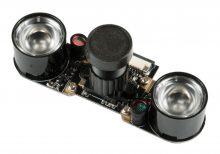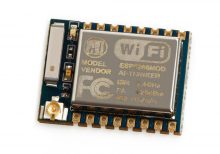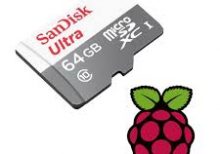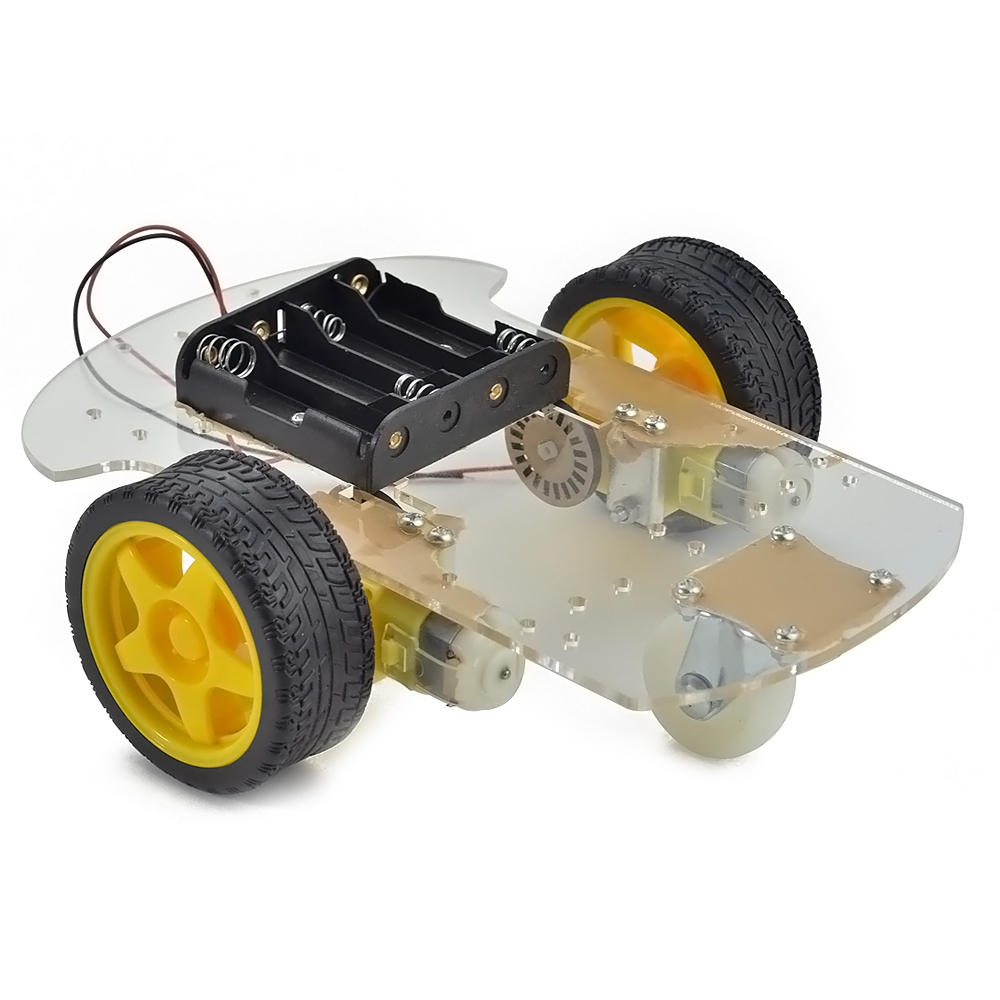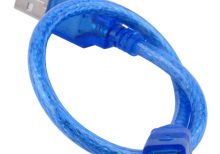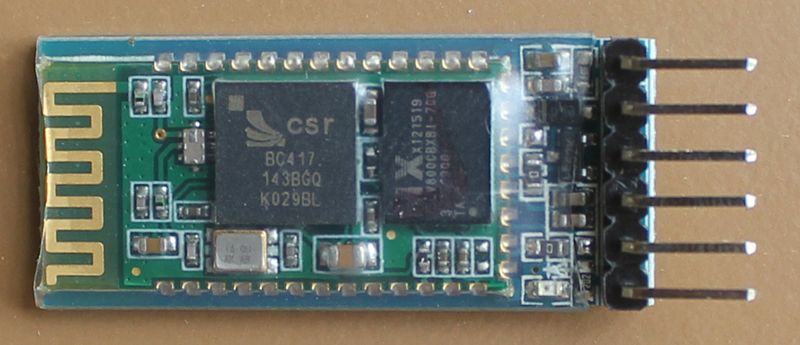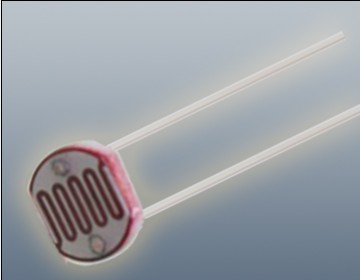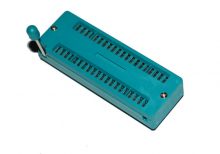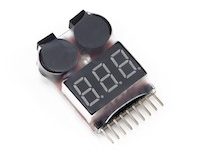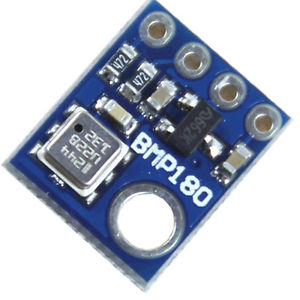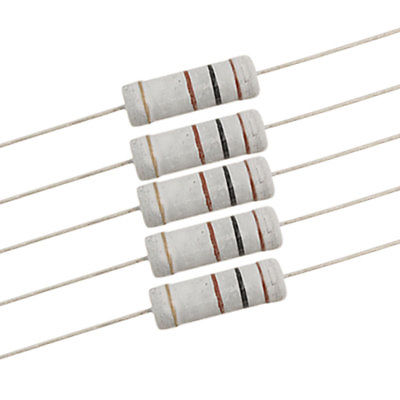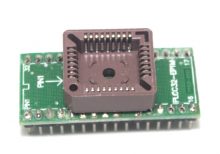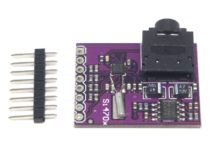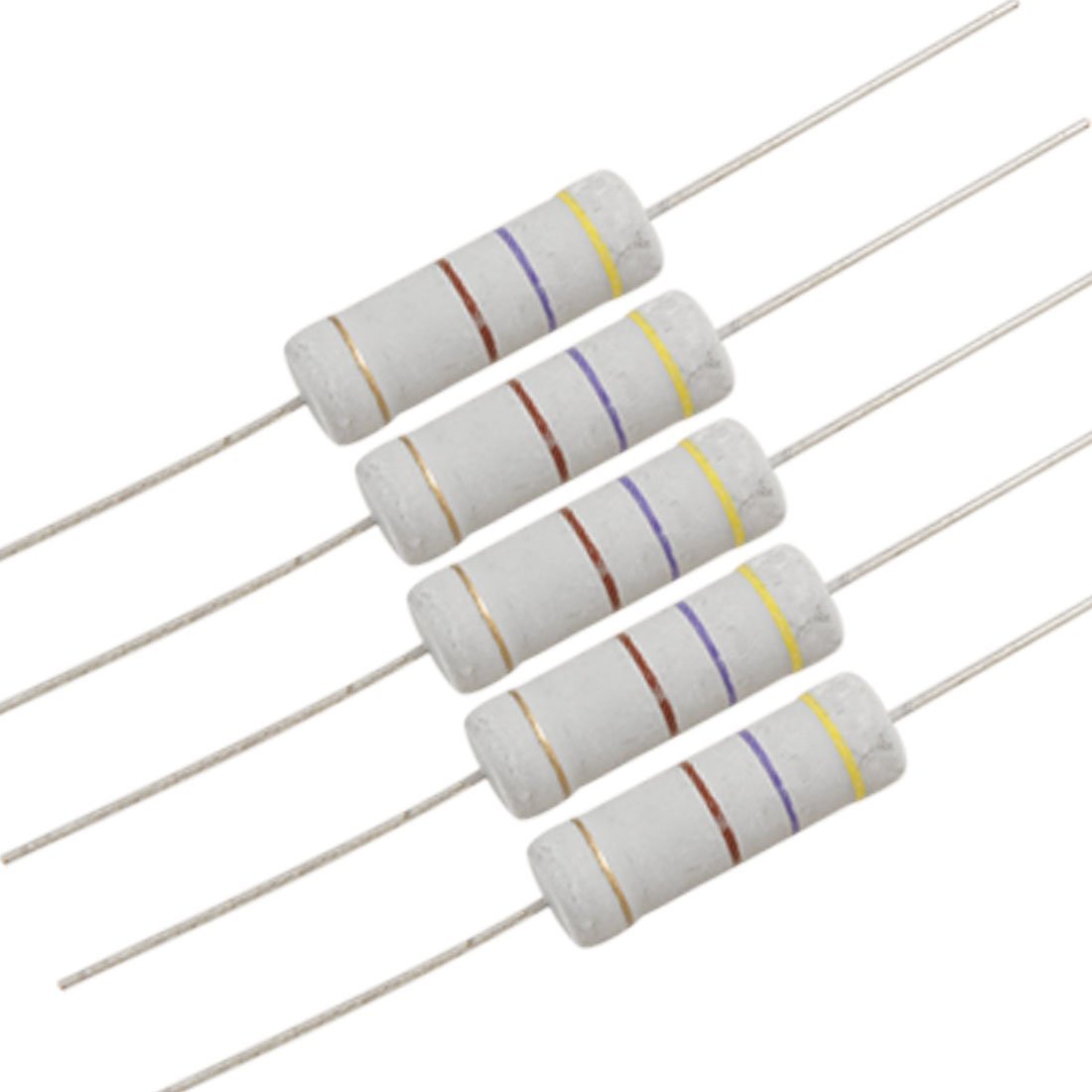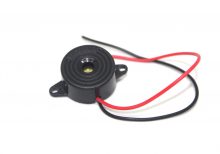|
Description |
The Raspberry Pi IR Night Vision 500W Camera is an advanced imaging module designed for Raspberry Pi boards, featuring a high-resolution 500W (500,000 pixels) sensor and infrared (IR) night vision capabilities. This camera is ideal for low-light and nighttime surveillance, as well as various imaging applications that require clear visuals in darkness.
Key Features:
- High Resolution: 500W (500,000 pixels) for clear and detailed imaging.
- Infrared Night Vision: Equipped with IR LEDs for effective night vision capabilities.
- Compatible with Raspberry Pi: Designed to work seamlessly with Raspberry Pi boards.
- Easy Integration: Simple to connect and integrate with Raspberry Pi for various applications.
- Wide Application Range: Suitable for surveillance, security systems, and night-time imaging.
Technical Specifications:
- Sensor Resolution: 500W (500,000 pixels)
- Infrared LEDs: Integrated for night vision and low-light performance.
- Interface: Compatible with Raspberry Pi via the camera interface (CSI).
- Field of View: Varies based on lens configuration.
- Power Supply: Powered through the Raspberry Pi board or external power source.
- Operating Temperature: Typically operates within standard temperature ranges for electronic devices.
Applications:
- Surveillance Systems: Ideal for security cameras and monitoring in low-light conditions.
- Night-Time Imaging: Provides clear visuals in darkness for various imaging needs.
- Raspberry Pi Projects: Useful for projects involving image capture and analysis.
- Security and Monitoring: Enhances security systems with night vision capabilities.
|
The 65mm Smart Car Tyre Narrow Wheel is designed for use in small robotics and smart car projects. These wheels provide excellent traction and durability, making them ideal for navigating various surfaces. Their narrow design allows for precise control and maneuverability, which is essential for robotics applications.
Key Features:
- Size: 65mm diameter, narrow width for precise control
- Durable Material: Made from high-quality rubber for enhanced durability and grip
- Easy Installation: Compatible with standard smart car and robot axles
- Smooth Performance: Ensures stable and smooth movement on various surfaces
- Lightweight: Lightweight construction for efficient energy use in small robotic projects
Technical Specifications:
- Diameter: 65mm
- Width: 8mm
- Material: High-quality rubber with plastic hub
- Axle Hole Diameter: 3mm
- Weight: 15g per wheel
- Color: Black
Applications:
- Smart Car Projects: Ideal for DIY smart car kits and educational robotics
- Robotics Competitions: Suitable for robotics competitions requiring precise control
- Line Following Robots: Enhances the performance of line-following robots
- Obstacle Avoidance Robots: Provides reliable movement for obstacle avoidance tasks
- Prototyping: Useful in various prototyping and small-scale robotics projects
|
The ESP8266 ESP-07 is a highly integrated Wi-Fi module designed to provide wireless connectivity to various IoT (Internet of Things) applications. With its compact design and robust performance, this module allows for easy integration of Wi-Fi capabilities into a wide range of devices. The ESP-07 features an onboard antenna and multiple GPIO pins, making it versatile for different projects and applications.
Key Features:
- Wi-Fi Connectivity: Supports 802.11 b/g/n Wi-Fi standards for reliable wireless communication.
- Compact Design: Small form factor for easy integration into space-constrained projects.
- Onboard Antenna: Built-in PCB antenna for stable wireless performance.
- Multiple GPIO Pins: Provides several General Purpose Input/Output pins for versatile interfacing.
- Integrated TCP/IP Stack: Simplifies network communication for developers.
- Low Power Consumption: Efficient power usage suitable for battery-powered applications.
- Easy Programming: Compatible with Arduino IDE and other development environments.
Technical Specifications:
- Wi-Fi Standards: 802.11 b/g/n
- Operating Voltage: 3.0V to 3.6V
- Flash Memory: 1MB (8Mbit)
- GPIO Pins: 9
- Operating Temperature Range: -40°C to +125°C
- Dimensions: 16mm x 24mm x 3mm
- Current Consumption:
- Standby: < 10uA
- Transmit: ~170mA
- Receive: ~50mA
- Antenna Type: Onboard PCB antenna
Applications:
- Home Automation: Wireless control of home devices and appliances.
- IoT Projects: Connecting sensors and actuators to the internet.
- Wireless Networking: Creating Wi-Fi hotspots and network bridges.
- Remote Monitoring: Monitoring and controlling systems remotely via Wi-Fi.
- Wearable Devices: Adding Wi-Fi connectivity to wearable electronics.
Datasheet:
For detailed technical specifications, refer to the ESP8266 ESP-07 Datasheet.
|
Description:
The Seven Segment High Precision Electronic Clock is a digital timekeeping device that displays the current time with high accuracy. Utilizing seven-segment LED displays, it provides a clear and easily readable representation of hours, minutes, and seconds. This clock is suitable for various applications, including industrial environments, educational settings, and personal use.
Key Features:
- High Precision Timekeeping: Ensures accurate time display with minimal drift over time.
- Seven-Segment LED Display: Provides clear and bright time readouts, easily visible from a distance.
- User-Friendly Interface: Simple controls for time setting and adjustments.
- Durable Construction: Built to withstand continuous use in various environments.
- Compact Design: Easily integrates into different spaces without occupying much room.
Technical Specifications:
- Display Type: Seven-segment LED
- Power Supply: Typically 5V DC
- Accuracy: ±1 second per month
- Operating Temperature Range: 0°C to +50°C
- Dimensions: Compact size for versatile installation options
- Weight: Lightweight design for ease of handling and mounting
Applications:
- Industrial Timing: Used in manufacturing plants and workshops for precise timekeeping.
- Educational Settings: Ideal for classrooms and laboratories for teaching time management and electronics.
- Personal Use: Suitable for home and office use to keep accurate track of time.
- Public Spaces: Can be installed in public areas such as lobbies, halls, and waiting rooms for time display.
|
The Raspberry Pi SD Card 64GB is a high-capacity microSD card designed to provide ample storage for your Raspberry Pi projects. This microSD card offers a significant amount of space for operating systems, applications, data, and multimedia files, ensuring smooth and efficient performance. It is ideal for more complex and storage-intensive projects using any Raspberry Pi model with a microSD card slot.
Key Features:
- 64GB storage capacity
- Pre-loaded with the Raspberry Pi operating system (optional)
- High-speed data transfer rates
- Reliable and durable design
- Compatible with all Raspberry Pi models with a microSD card slot
- Ideal for projects requiring substantial storage space
- Easy to set up and use
Technical Specifications:
- Capacity: 64GB
- Format: MicroSDXC
- Speed Class: Class 10, UHS-I or UHS-II (varies by model)
- Read Speed: Up to 100MB/s (varies by model)
- Write Speed: Up to 90MB/s (varies by model)
- Operating Voltage: 2.7V to 3.6V
- Operating Temperature: -25°C to +85°C
- Storage Temperature: -40°C to +85°C
- Dimensions: Standard microSD card size
Applications:
- Raspberry Pi OS and application storage
- Data logging and storage
- Multimedia projects
- IoT applications
- Education and development projects
- Complex software development and testing
Datasheet:
For detailed technical information, please refer to the MicroSD Card Datasheet.
|
The 2WD Motor Chassis is a versatile and robust platform designed for building small robotic vehicles. This chassis kit includes two DC motors with wheels and a sturdy frame, providing an excellent foundation for creating custom robots, educational projects, and prototyping. The design allows easy integration with various microcontrollers, sensors, and other electronic components.
Key Features:
- Sturdy and durable construction
- Two high-quality DC motors with wheels
- Easy to assemble and modify
- Compatible with various microcontrollers and sensors
- Ample space for mounting additional components
- Suitable for indoor and outdoor use
Technical Specifications:
- Material: Acrylic or metal (varies by model)
- Dimensions: Approx. 170mm x 100mm x 60mm (assembled size may vary)
- Weight: Approx. 200g (including motors and wheels)
- Motors: Two DC motors (typically 3V-6V)
- Wheels: Two rubber wheels, diameter approx. 65mm
- Chassis Frame: Pre-drilled holes for easy component mounting
- Power Supply: Varies based on motor specifications (typically 3V-6V)
- Load Capacity: Suitable for small to medium-sized robots
- Operating Temperature Range: -10°C to +50°C
Applications:
- Educational Projects: Ideal for teaching robotics and electronics in schools and universities.
- Prototyping: Useful for developing and testing robotic designs and concepts.
- DIY Robotics: Perfect for hobbyists and enthusiasts building custom robots.
- Obstacle Avoidance Robots: Suitable for creating robots that navigate through obstacles.
- Line Following Robots: Can be used to build robots that follow predefined paths.
Usage:
- Assemble the chassis by attaching the motors and wheels to the frame.
- Connect the motors to your microcontroller or motor driver.
- Mount any additional sensors, controllers, or electronic components.
- Power the motors and program your microcontroller to control the chassis.
- Test and adjust the configuration to suit your specific robotic application.
Caution:
- Ensure proper handling and assembly to avoid damaging the chassis or motors.
- Verify the power supply voltage and current specifications before powering the motors.
- Avoid excessive loads that may strain the motors or chassis structure.
- Follow safety guidelines when working with electronic components and tools.
Datasheet:
For detailed technical specifications, refer to the 2WD Motor Chassis Datasheet.
|
The ESP8266 01S is a low-cost WiFi module that allows microcontrollers to connect to a WiFi network and make simple TCP/IP connections using Hayes-style commands. It is an improved version of the popular ESP8266-01 module, featuring better stability and performance. The module is ideal for IoT (Internet of Things) applications, enabling devices to communicate wirelessly with the internet or local network.
Key Features:
- Integrated TCP/IP protocol stack
- WiFi 802.11 b/g/n support
- Built-in low-power 32-bit CPU, can also function as an application processor
- 1MB of Flash memory
- Supports AP (Access Point), STA (Station), and AP+STA modes
- UART interface for easy integration
- Wide range of GPIOs for connecting sensors and peripherals
- Compact and lightweight design
Technical Specifications:
- Microcontroller: Tensilica L106 32-bit RISC processor, running at 80 MHz
- Operating Voltage: 3.0V to 3.6V
- Flash Memory: 1MB
- RAM: 50 kB
- WiFi Standards: 802.11 b/g/n
- Frequency Range: 2.4 GHz to 2.5 GHz
- Data Rate: Up to 1 Mbps
- UART Baud Rate: 9600 bps (default)
- GPIO Pins: 2 (GPIO0 and GPIO2)
- Operating Current: 70 mA (typical)
- Deep Sleep Current: < 10 µA
- Operating Temperature: -40°C to +125°C
- Dimensions: 25mm x 15mm x 6mm
Applications:
- Internet of Things (IoT) devices
- Home automation
- Wireless sensor networks
- Remote data logging
- Smart appliances
- Wearable technology
- DIY electronics projects
Usage:
- Connection:
- Connect the VCC pin to a 3.3V power supply and GND to ground.
- Connect the TX and RX pins to the UART interface of the microcontroller (with proper voltage level shifting if necessary).
- Use GPIO0 and GPIO2 for additional control and sensor connections.
- Programming:
- Use AT commands to configure and control the module via a serial interface.
- Optionally, use the Arduino IDE or other compatible development environments to write custom firmware for the ESP8266.
- WiFi Configuration:
- Configure the WiFi settings (SSID and password) using AT commands or custom firmware.
- Establish TCP/IP connections for data communication with remote servers or local networks.
Caution:
- Ensure the module operates within the specified voltage range to avoid damage.
- Handle the module carefully to avoid static discharge and physical damage.
- Use proper level shifting for UART communication if connecting to a 5V microcontroller.
Datasheet:
For detailed technical specifications, refer to the ESP8266 01S Datasheet.
|
Description:
The 5mm 8×8 Dot Matrix is a versatile LED display module designed for a wide range of applications, including text display, graphical displays, and status indicators. The matrix consists of 64 individual LEDs arranged in an 8×8 grid, providing bright and clear visual output. This module is ideal for use in digital clocks, scoreboards, message boards, and various electronic projects.
Key Features:
- Matrix Configuration: 8×8 grid of LEDs, offering a total of 64 LEDs
- LED Size: 5mm diameter LEDs for bright and clear display
- Display Type: Suitable for alphanumeric characters and simple graphics
- Brightness: High brightness for visibility in various lighting conditions
- Driver Compatibility: Compatible with common LED drivers and controllers for easy integration
- Versatile Use: Can be used for creating dynamic visual effects, messages, and notifications
Technical Specifications:
- Matrix Size: 8×8 (64 LEDs)
- LED Diameter: 5mm
- Operating Voltage: Typically 5V DC
- Color: Typically single color (e.g., red, green, or blue)
- Interface: Requires compatible LED driver/controller for operation
- Dimensions: Compact design for easy integration into various projects
- Weight: Lightweight for easy mounting
Applications:
- Digital Displays: Used in digital clocks and scoreboards for clear numeric and text display
- Message Boards: Ideal for scrolling or static messages in public or private displays
- Decorative Lighting: Useful for creating visual effects and lighting patterns
- Electronic Projects: Suitable for hobbyist projects involving LED display
|
The 30cm Arduino Nano Cable is a compact, high-quality cable designed for connecting Arduino Nano boards to various peripherals or devices. Its short length makes it ideal for use in tight spaces or small projects where a longer cable might be cumbersome. This cable is typically used for programming the Arduino Nano or for connecting it to external components such as sensors, displays, or other microcontrollers.
Key Features:
- Length: 30 cm
- Connector Type: Compatible with Arduino Nano boards
- Connector Style: USB Type-B (or other variants depending on the model)
- Durability: High-quality construction for reliable performance
- Compatibility: Designed to fit Arduino Nano board pinouts
- Color: Varies by manufacturer
Technical Specifications:
- Cable Length: 30 cm
- Connector Type: USB Type-B to USB Type-A (or other variant as applicable)
- Material: Typically copper conductors with PVC insulation
- Data Transfer Rate: Depends on USB standard (usually USB 2.0)
- Operating Temperature Range: -20°C to +60°C
Applications:
- Connecting Arduino Nano boards to PCs for programming and communication
- Linking Arduino boards with external devices or peripherals
- Ideal for use in compact or portable projects where space is limited
Usage:
- Plug the USB Type-B connector into the Arduino Nano board.
- Connect the other end to a PC or other USB-enabled device.
- Ensure proper connection for reliable data transfer and device communication.
Caution:
- Avoid excessive bending or twisting of the cable to prevent damage.
- Ensure connectors are properly aligned before inserting to avoid physical damage.
- Use the cable within the specified temperature range to maintain performance.
Datasheet:
For detailed technical specifications, refer to the 30cm Arduino Nano Cable Datasheet.
|
The Allen key, also known as a hex key or hex wrench, is a tool used to drive screws and bolts with hexagonal sockets. The Size 3 mm Allen key is designed for fasteners with a 3 mm hexagonal socket, making it suitable for various applications in mechanical, electrical, and DIY projects.
Key Features:
- Size: 3 mm (hexagonal socket size)
- Shape: Typically L-shaped or T-shaped
- Material: Often made from high-strength steel or chrome vanadium for durability and longevity
- Finish: Commonly coated with black oxide, chrome plating, or other protective finishes to resist corrosion
- Type: Available in different designs, such as short or long arm, and sometimes with a ball end for ease of use in tight spaces
Technical Specifications:
- Hexagon Size: 3 mm
- Length: Varies by design, e.g., 50 mm to 120 mm for short arms, and longer for T-handle or L-handle versions
- Material: Steel, chrome vanadium, or other hardened materials
- Finish: Black oxide, chrome-plated, or other protective coatings
Applications:
- Mechanical Work: Ideal for tasks involving screws and bolts in machinery and automotive applications.
- Furniture Assembly: Commonly used for assembling flat-pack furniture.
- Bicycles: Useful for adjusting and tightening components on bicycles.
- Electronics: Essential for assembling and repairing electronic devices with hex screws.
- DIY Projects: Suitable for various home improvement and hobbyist tasks.
Datasheet:
Allen keys generally do not have detailed datasheets, but tool manufacturers or suppliers can provide specifications.
|
The HC-05 Bluetooth module is a versatile and user-friendly wireless communication device designed for seamless integration with microcontrollers and embedded systems. It supports Bluetooth 2.0+EDR (Enhanced Data Rate) and provides reliable and efficient wireless data transmission. The module is commonly used in wireless control and data exchange applications, including home automation, robotics, and wireless sensor networks.
Key Features:
- Supports Bluetooth 2.0+EDR
- Easy to integrate with microcontrollers via UART interface
- Supports master and slave modes
- Built-in antenna for reliable wireless communication
- Configurable via AT commands
- LED indicators for connection status
- Low power consumption
Technical Specifications:
- Bluetooth Version: 2.0+EDR
- Frequency Range: 2.4GHz ISM band
- Operating Voltage: 3.3V to 5V
- Communication Protocol: UART (default baud rate: 9600 bps)
- Range: Up to 10 meters (unobstructed)
- Power Consumption: 30mA in active mode, 8mA in idle mode
- Dimensions: 37mm x 15mm x 3mm (varies slightly by manufacturer)
- Operating Temperature Range: -20°C to +75°C
Applications:
- Wireless control of devices
- Data exchange between microcontrollers and smartphones
- Home automation systems
- Robotics and RC projects
- Wireless sensor networks
- Prototyping and educational projects
Usage:
- Connect the HC-05 module to your microcontroller or development board using the UART interface (TX, RX, VCC, and GND pins).
- Power the module with a voltage within the specified range (3.3V to 5V).
- Use AT commands to configure the module’s settings, such as baud rate, mode (master/slave), and pairing details.
- Pair the HC-05 module with another Bluetooth-enabled device (e.g., smartphone, PC) to establish a wireless connection.
- Exchange data between the paired devices via the UART interface.
Caution:
- Ensure the power supply voltage is within the specified range to avoid damaging the module.
- Handle the module carefully to avoid physical damage to the components and antenna.
- Verify the UART connections to ensure proper communication between the module and the microcontroller.
Datasheet:
For detailed technical specifications, refer to the HC-05 Datasheet.
|
The Photoresistor LDR (Light Dependent Resistor) is a variable resistor whose resistance changes with the light intensity that falls upon it. It is widely used in light sensing applications and projects where detecting light levels is essential. LDRs are cost-effective, easy to use, and suitable for various electronic projects, including light meters, street lights, and other light-sensitive devices.
Key Features:
- Light Sensitivity: Resistance decreases with increasing light intensity
- Simple Interface: Easy to integrate with microcontrollers and analog circuits
- Low Cost: Economical solution for light detection
- Wide Range of Light Detection: Can detect various light levels from low to high intensity
- Compact Size: Fits easily into small projects
Technical Specifications:
- Resistance in Darkness: Typically 1MΩ (depending on specific model)
- Resistance in Bright Light: Typically 10-20kΩ (depending on specific model)
- Spectral Peak: Approximately 540nm (most sensitive to green light)
- Response Time: Rise time ~20ms, fall time ~30ms
- Operating Temperature Range: -30°C to +70°C
- Diameter: Typically 5mm to 10mm (depending on specific model)
Applications:
- Light Meters: Measure light intensity for photography and scientific applications.
- Street Lights: Automatic on/off control based on ambient light levels.
- Alarm Systems: Detect changes in light levels for security purposes.
- Consumer Electronics: Light-sensitive control in devices like clocks and displays.
- Educational Projects: Common component in learning modules for electronics.
Usage:
- Circuit Integration: Connect the LDR in a voltage divider circuit with a fixed resistor to create a variable voltage output based on light intensity.
- Microcontroller Interface: Read the voltage output from the LDR circuit using an analog input pin on a microcontroller.
- Programming: Write code to interpret the analog signal and perform actions based on light levels (e.g., turning on an LED when it gets dark).
- Testing: Calibrate the LDR circuit for the desired light sensitivity by adjusting the fixed resistor value.
Caution:
- Environment: Avoid exposure to extreme temperatures and humidity, which may affect the LDR’s performance.
- Handling: Handle with care to avoid damaging the sensitive surface of the LDR.
Datasheet:
For detailed technical specifications, refer to the Photoresistor LDR Datasheet.
|
A Wide Width ZIF (Zero Insertion Force) Socket with 40 pins is designed for easy and reliable connection of integrated circuits (ICs) to a circuit board without the need for soldering. The ZIF socket allows ICs to be inserted and removed without applying force, making it ideal for use in testing, prototyping, and programming applications where frequent changes to the IC may be required.
Key Features:
- 40-pin ZIF socket for ICs with a 40-pin configuration
- Zero insertion force mechanism for easy IC insertion and removal
- Wide width design to accommodate various IC packages
- Durable construction for reliable performance
- Suitable for use in testing, prototyping, and programming
Technical Specifications:
- Pin Count: 40
- Pin Pitch: 2.54mm (0.1 inch)
- Contact Type: ZIF (Zero Insertion Force)
- Socket Type: Wide width for expanded IC package compatibility
- Material: High-quality plastic and metal contacts
- Operating Temperature Range: Typically -25°C to +85°C
Applications:
- IC testing and programming
- Prototyping and development
- Repair and maintenance of electronic equipment
- Educational and experimental projects
Usage:
- Align the IC with the socket pins, ensuring proper orientation.
- Open the ZIF socket by lifting the lever or handle.
- Insert the IC into the socket carefully.
- Close the ZIF socket by pressing the lever or handle down to secure the IC in place.
- Remove the IC by reversing the insertion process.
Caution:
- Ensure correct pin alignment to avoid damaging the IC or socket.
- Avoid applying excessive force when inserting or removing the IC.
- Handle with care to prevent bending or damaging the pins.
|
Description:
The 1-8S LiPo battery voltage detector with buzzer is an essential tool for monitoring and ensuring the safe operation of lithium polymer (LiPo) batteries used in RC models, drones, and other electronic devices. It provides real-time voltage detection for 1 to 8 series LiPo batteries, alerting users to low voltage conditions with an audible buzzer alarm. This compact device helps prevent over-discharge, which can damage batteries and reduce their lifespan, ensuring optimal performance and safety during use.
Key Features:
- Compatible Battery Types: 1-8S LiPo/Li-ion/LiMn/LiFe
- Voltage Detection Range: 2.7V to 25.2V (1S to 8S)
- Audible Buzzer Alarm: Alerts when voltage drops below preset levels
- Compact and Lightweight: Easy to carry and use in the field
- LED Indicators: Display battery voltage status for quick reference
- Reverse Polarity Protection: Prevents damage due to incorrect battery connection
Technical Specifications:
- Input Voltage: DC 5-27V (powered by the battery being tested)
- Accuracy: ±0.01V
- Operating Temperature: 0°C to 40°C
- Dimensions: Compact and portable design
- Weight: Lightweight for easy handling
Applications:
- RC Models (Cars, Planes, Boats)
- Drones and UAVs (Unmanned Aerial Vehicles)
- Portable Electronic Devices
- Battery Maintenance and Monitoring
|
The BMP180 is a high-precision digital barometer and altitude sensor from Bosch, designed to measure atmospheric pressure and temperature. It is commonly used in applications requiring accurate altitude measurement and weather monitoring. The BMP180 provides reliable data for various applications including GPS, weather stations, and altitude tracking in wearable devices.
Key Features:
- Accurate barometric pressure and temperature measurement
- Digital interface with I²C or SPI communication
- High resolution with 0.03 hPa pressure measurement accuracy
- Compact and low-power design
- Built-in calibration for precise readings
- Wide operating temperature range
Technical Specifications:
- Sensor Type: Barometric Pressure and Temperature Sensor
- Communication Protocol: I²C (default), SPI (optional)
- Pressure Range: 300 hPa to 1100 hPa
- Pressure Accuracy: ±1 hPa (typical)
- Temperature Range: -40°C to +85°C
- Temperature Accuracy: ±1°C
- Resolution: 0.03 hPa for pressure
- Operating Voltage: 1.8V to 3.6V
- Current Consumption: 3µA (typical in sleep mode), 10µA (typical in measurement mode)
- Package Type: LGA-8 (Leadless Grid Array)
Applications:
- Altitude and weather tracking
- GPS altitude calibration
- Pressure-based data logging
- Environmental monitoring
- Wearable devices and consumer electronics
Usage:
- Connect the BMP180 sensor to your microcontroller or development board using I²C or SPI interface.
- Power the sensor with a voltage within the operating range (1.8V to 3.6V).
- Use the appropriate library or driver for the I²C or SPI protocol to interface with the sensor.
- Retrieve and process pressure and temperature data according to your application needs.
Caution:
- Ensure proper voltage supply to avoid damage to the sensor.
- Handle the sensor carefully to prevent mechanical damage or contamination.
- Verify correct wiring and communication protocol settings for accurate readings.
Datasheet:
For detailed technical specifications, refer to the BMP180 Datasheet.
|
The 100Ω 2W resistor is a fixed-value resistor designed for applications that require moderate power dissipation. It is used to limit current, divide voltage, and protect components in various electronic circuits. This resistor is suitable for power supply circuits, audio equipment, and other applications where reliable performance and high power handling are essential.
Key Features:
- Fixed resistance value of 100Ω
- Power rating of 2 watts
- Flame-resistant coating for safety
- High reliability and stability
- Axial leads for easy mounting on printed circuit boards (PCBs)
- Suitable for a wide range of electronic applications
Technical Specifications:
- Resistance Value: 100Ω
- Power Rating: 2W
- Tolerance: ±5% (J) or ±1% (F), depending on the model
- Temperature Coefficient: ±200 ppm/°C
- Operating Temperature Range: -55°C to +155°C
- Body Size: Approx. 5.5mm (Diameter) x 15mm (Length)
- Lead Diameter: Approx. 0.8mm
- Material: Metal oxide film or carbon film
- Maximum Working Voltage: 350V
- Maximum Overload Voltage: 600V
Applications:
- Power Supplies: Used in power supply circuits for current limiting and voltage division.
- LED Drivers: Ideal for controlling the current flow in LED circuits.
- Audio Equipment: Suitable for audio crossover networks and other audio applications.
- General Electronics: Used in a variety of electronic devices and circuits.
- Industrial Equipment: Suitable for industrial control and automation systems.
Usage:
- Identify the resistor’s resistance value and power rating by reading the color code or label.
- Solder the resistor onto the PCB or connect it into the circuit using the axial leads.
- Ensure the resistor is placed in a location that allows for adequate heat dissipation.
- Verify the resistor’s connections and test the circuit to ensure proper operation.
Caution:
- Do not exceed the resistor’s maximum power rating to avoid overheating and potential failure.
- Ensure proper ventilation and heat dissipation when using the resistor in high-power applications.
- Handle with care to prevent damage to the resistor’s leads and coating.
- Verify the resistor’s resistance value and tolerance before use in precision circuits.
|
The PLCC32 to DIP32 IC Socket Adapter is used to convert a 32-pin PLCC (Plastic Leaded Chip Carrier) IC package into a 32-pin DIP (Dual Inline Package) configuration. This adapter allows for the integration of PLCC32 ICs into DIP socket-compatible boards, making it ideal for prototyping and development applications.
Key Features:
- Convenient Conversion: Transforms a 32-pin PLCC IC to a 32-pin DIP format for easier handling and testing.
- Durable Construction: Made with high-quality materials to ensure reliable performance and longevity.
- Gold-Plated Contacts: Provides excellent conductivity and minimizes the risk of corrosion.
- Compact Design: Fits standard DIP sockets and breadboards for versatile use.
- Easy Installation: Allows for quick and easy insertion and removal of ICs.
Technical Specifications:
- Package Type: PLCC32 to DIP32
- Pin Pitch (PLCC): 1.27mm
- Pin Pitch (DIP): 2.54mm
- Material: FR4 PCB, Gold-plated contacts
- Dimensions: Varies by model
- Weight: Lightweight
- Temperature Range: -40°C to +85°C
- Mounting Type: Through-hole
Applications:
- Prototyping: Enables the use of PLCC32 ICs in DIP-compatible prototyping setups.
- Development: Facilitates integration of PLCC32 devices into DIP-based circuit designs.
- Repair and Replacement: Adapts PLCC32 ICs for use in existing DIP-based systems.
- Educational Use: Ideal for demonstrating IC package conversion in educational settings.
|
The 1KΩ 2W resistor is a fixed-value resistor designed for applications that require moderate power dissipation. It is used to limit current, divide voltage, and protect components in various electronic circuits. This resistor is suitable for power supply circuits, audio equipment, and other applications where reliable performance and high power handling are essential.
Key Features:
- Fixed resistance value of 1KΩ
- Power rating of 2 watts
- Flame-resistant coating for safety
- High reliability and stability
- Axial leads for easy mounting on printed circuit boards (PCBs)
- Suitable for a wide range of electronic applications
Technical Specifications:
- Resistance Value: 1KΩ
- Power Rating: 2W
- Tolerance: ±5% (J) or ±1% (F), depending on the model
- Temperature Coefficient: ±200 ppm/°C
- Operating Temperature Range: -55°C to +155°C
- Body Size: Approx. 5.5mm (Diameter) x 15mm (Length)
- Lead Diameter: Approx. 0.8mm
- Material: Metal oxide film or carbon film
- Maximum Working Voltage: 350V
- Maximum Overload Voltage: 600V
Applications:
- Power Supplies: Used in power supply circuits for current limiting and voltage division.
- LED Drivers: Ideal for controlling the current flow in LED circuits.
- Audio Equipment: Suitable for audio crossover networks and other audio applications.
- General Electronics: Used in a variety of electronic devices and circuits.
- Industrial Equipment: Suitable for industrial control and automation systems.
Usage:
- Identify the resistor’s resistance value and power rating by reading the color code or label.
- Solder the resistor onto the PCB or connect it into the circuit using the axial leads.
- Ensure the resistor is placed in a location that allows for adequate heat dissipation.
- Verify the resistor’s connections and test the circuit to ensure proper operation.
Caution:
- Do not exceed the resistor’s maximum power rating to avoid overheating and potential failure.
- Ensure proper ventilation and heat dissipation when using the resistor in high-power applications.
- Handle with care to prevent damage to the resistor’s leads and coating.
- Verify the resistor’s resistance value and tolerance before use in precision circuits.
|
The MCU-470 Si4703 FM Tuner Development Board is a versatile and compact module designed for developing and experimenting with FM radio reception. Based on the Si4703 FM tuner IC, this board provides a robust platform for integrating FM radio functionality into various electronic projects. It features easy-to-use controls and interfaces for tuning, volume adjustment, and signal reception, making it suitable for both prototyping and educational purposes.
Key Features:
- Si4703 FM Tuner IC: Provides high-quality FM radio reception with good sensitivity and selectivity.
- Digital Tuning: Allows precise frequency tuning and easy channel selection.
- Integrated LCD Display: Shows frequency and status information for easy monitoring.
- User-Friendly Interface: Includes controls for tuning, volume adjustment, and channel scanning.
- Compact Design: Small form factor for easy integration into various projects.
- Compatible with Development Boards: Easily integrates with popular microcontroller development boards for custom applications.
Technical Specifications:
- FM Tuner IC: Si4703
- Frequency Range: 76MHz to 108MHz (FM band)
- Tuning Steps: 100kHz
- Audio Output: Mono or stereo (depends on implementation)
- Display: Integrated LCD for frequency and status display
- Power Supply: 5V DC (via USB or external power)
- Dimensions: 60mm x 50mm x 15mm (approx.)
- Weight: 80g (approx.)
Applications:
- FM Radio Projects: Ideal for DIY FM radio receiver projects and experiments.
- Educational Use: Suitable for learning and teaching about FM radio technology and circuitry.
- Prototyping: Useful for developing and testing FM radio functions in electronic devices.
- Embedded Systems: Can be integrated into embedded systems requiring FM radio capabilities.
- Hobbyist Electronics: Perfect for electronics enthusiasts and makers working on radio-based projects.
Datasheet:
For detailed technical specifications, refer to the Si4703 FM Tuner IC Datasheet and MCU-470 Development Board Datasheet.
|
The SOP8 to DIP8 IC Socket Adapter is designed to facilitate the use of SOP8 (Small Outline Package) integrated circuits with DIP8 (Dual Inline Package) sockets. This adapter is ideal for prototyping and testing applications where surface-mount devices need to be used with through-hole PCB designs.
Key Features:
- Easy Conversion: Converts SOP8 ICs to DIP8 format for compatibility with standard DIP sockets.
- High-Quality Construction: Made from durable materials to ensure reliable connections.
- Gold-Plated Contacts: Provides excellent conductivity and corrosion resistance.
- Compact Design: Fits easily onto breadboards and other prototyping platforms.
- Reusable: Can be used multiple times for different projects and ICs.
Technical Specifications:
- Package Type: SOP8 to DIP8
- Pin Pitch (SOP): 1.27mm
- Pin Pitch (DIP): 2.54mm
- Material: FR4 PCB, Gold-plated contacts
- Dimensions: Varies by model
- Weight: Lightweight design
- Temperature Range: -40°C to +85°C
- Mounting Type: Through-hole
Applications:
- Prototyping: Allows for easy testing of SOP8 ICs on breadboards and standard PCBs.
- Development: Facilitates the development of circuits using surface-mount devices.
- Repair and Replacement: Useful for replacing SOP8 ICs with DIP8 ICs in existing designs.
- Education: Ideal for educational purposes to demonstrate the use of different IC packages.
|
The 470Ω 2W resistor is a fixed-value resistor designed for applications that require moderate power dissipation. It is used to limit current, divide voltage, and protect components in various electronic circuits. This resistor is suitable for power supply circuits, audio equipment, and other applications where reliable performance and high power handling are essential.
Key Features:
- Fixed resistance value of 470Ω
- Power rating of 2 watts
- Flame-resistant coating for safety
- High reliability and stability
- Axial leads for easy mounting on printed circuit boards (PCBs)
- Suitable for a wide range of electronic applications
Technical Specifications:
- Resistance Value: 470Ω
- Power Rating: 2W
- Tolerance: ±5% (J) or ±1% (F), depending on the model
- Temperature Coefficient: ±200 ppm/°C
- Operating Temperature Range: -55°C to +155°C
- Body Size: Approx. 5.5mm (Diameter) x 15mm (Length)
- Lead Diameter: Approx. 0.8mm
- Material: Metal oxide film or carbon film
- Maximum Working Voltage: 350V
- Maximum Overload Voltage: 600V
Applications:
- Power Supplies: Used in power supply circuits for current limiting and voltage division.
- LED Drivers: Ideal for controlling the current flow in LED circuits.
- Audio Equipment: Suitable for audio crossover networks and other audio applications.
- General Electronics: Used in a variety of electronic devices and circuits.
- Industrial Equipment: Suitable for industrial control and automation systems.
Usage:
- Identify the resistor’s resistance value and power rating by reading the color code or label.
- Solder the resistor onto the PCB or connect it into the circuit using the axial leads.
- Ensure the resistor is placed in a location that allows for adequate heat dissipation.
- Verify the resistor’s connections and test the circuit to ensure proper operation.
Caution:
- Do not exceed the resistor’s maximum power rating to avoid overheating and potential failure.
- Ensure proper ventilation and heat dissipation when using the resistor in high-power applications.
- Handle with care to prevent damage to the resistor’s leads and coating.
- Verify the resistor’s resistance value and tolerance before use in precision circuits.
|
Description: The SFM-10B is a high-decibel active buzzer designed for a wide voltage range of 3 to 24VDC. It provides a loud and clear sound output, making it ideal for alarms, notifications, and various signaling applications. The active buzzer requires no external drive circuit, simplifying integration into your projects.
Key Features:
- High-decibel sound output
- Wide operating voltage range: 3-24VDC
- Active buzzer design (requires no external drive circuit)
- Compact and robust construction
- Easy to integrate into various applications
Technical Specifications:
- Operating Voltage: 3V to 24V DC
- Sound Output: 85dB to 100dB (depending on voltage)
- Frequency: 2300 ± 300 Hz
- Current Consumption: <30mA (at 12V)
- Operating Temperature Range: -20°C to +60°C
Applications:
- Alarm systems
- Notification devices
- Signal output for various electronic projects
- Industrial equipment
- DIY electronics projects
|
